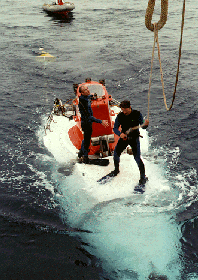This is an image of the Alvin being recovered by divers.
Click on image for full size
Image from: Woods Hole Oceanographic Institute, photo by Rod Castiac
The Alvin
Deep sea trenches are just that - really deep! They can be a couple miles deeper than the average depth of the ocean floor (4 miles). It is hard for humans to travel there because the pressures along the ocean bottom are so extreme.
The Alvin was the first deep-sea submersible. It was designed by scientists to explore the ocean floor, including the deep sea trenches. Between 1964 and 1999, the Alvin made 3,535 dives. The average depth for a dive was 1.28 miles (2,055 meters). The total number of people carried by the Alvin was 10,540. So, most dives carried 3 people aboard. The Alvin helps scientists to carry out research underwater in the areas of geology, biology and chemistry. It also helps inspect underwater structures and search for sunken vessels.
Research vessels like the Alvin allow humans to find such creatures as tube worms which live near vents along the ocean floor. The next image shows a view of the Alvin underwater.
Last modified May 5, 2003 by Lisa Gardiner.
You might also be interested in:
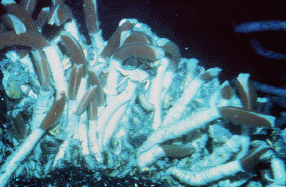
There are many types of living things that are able to live in difficult environments on Earth. The picture to the left shows an example of some of these creatures. These are tubeworms that live at the
...more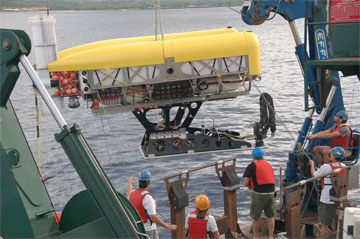
A new remotely operated vehicle (ROV) called Nereus has dived 10,902 meters, the deepest dive to date. The robot spent about 10 hours in the Mariana Trench, the deepest part of the ocean and the boundary
...more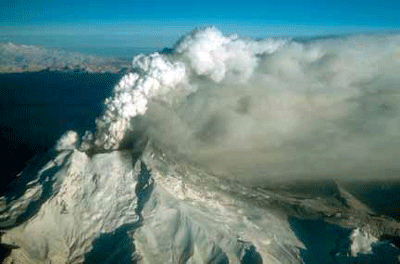
Ash is made of millions of tiny fragments of rock and glass formed during a volcanic eruption. Volcanic ash particles are less than 2 mm in size and can be much smaller. Volcanic ash forms in several ways
...more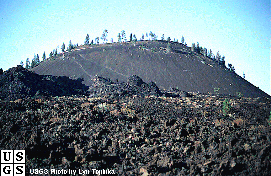
Cinder cones are simple volcanoes which have a bowl-shaped crater at the summit and only grow to about a thousand feet, the size of a hill. They usually are created of eruptions from a single opening,
...more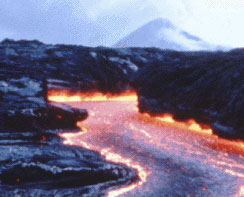
Lava can move in broad flat lava flows, or it can move through tight channels or tubes. Lava flows tend to cool quickly and flow slowly. The fastest lava outside of channels moves at about 6 mi/hr an easy
...more
Plates at our planet’s surface move because of the intense heat in the Earth’s core that causes molten rock in the mantle layer to move. It moves in a pattern called a convection cell that forms when
...more
Many kinds of surface features are clues that our lithosphere is sliding. Two types of features can form when plates move apart. At mid ocean ridges, the bottom of the sea splits apart and new crust is
...more


